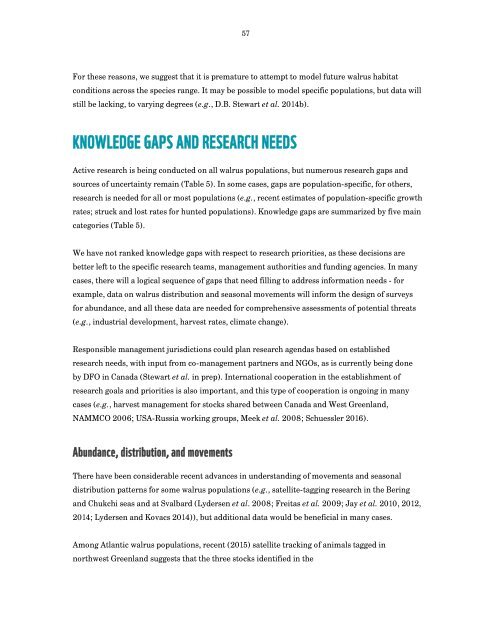The State of Circumpolar Walrus Populations
walrusreport
walrusreport
Create successful ePaper yourself
Turn your PDF publications into a flip-book with our unique Google optimized e-Paper software.
57<br />
For these reasons, we suggest that it is premature to attempt to model future walrus habitat<br />
conditions across the species range. It may be possible to model specific populations, but data will<br />
still be lacking, to varying degrees (e.g., D.B. Stewart et al. 2014b).<br />
KNOWLEDGE GAPS AND RESEARCH NEEDS<br />
Active research is being conducted on all walrus populations, but numerous research gaps and<br />
sources <strong>of</strong> uncertainty remain (Table 5). In some cases, gaps are population-specific, for others,<br />
research is needed for all or most populations (e.g., recent estimates <strong>of</strong> population-specific growth<br />
rates; struck and lost rates for hunted populations). Knowledge gaps are summarized by five main<br />
categories (Table 5).<br />
We have not ranked knowledge gaps with respect to research priorities, as these decisions are<br />
better left to the specific research teams, management authorities and funding agencies. In many<br />
cases, there will a logical sequence <strong>of</strong> gaps that need filling to address information needs - for<br />
example, data on walrus distribution and seasonal movements will inform the design <strong>of</strong> surveys<br />
for abundance, and all these data are needed for comprehensive assessments <strong>of</strong> potential threats<br />
(e.g., industrial development, harvest rates, climate change).<br />
Responsible management jurisdictions could plan research agendas based on established<br />
research needs, with input from co-management partners and NGOs, as is currently being done<br />
by DFO in Canada (Stewart et al. in prep). International cooperation in the establishment <strong>of</strong><br />
research goals and priorities is also important, and this type <strong>of</strong> cooperation is ongoing in many<br />
cases (e.g., harvest management for stocks shared between Canada and West Greenland,<br />
NAMMCO 2006; USA-Russia working groups, Meek et al. 2008; Schuessler 2016).<br />
Abundance, distribution, and movements<br />
<strong>The</strong>re have been considerable recent advances in understanding <strong>of</strong> movements and seasonal<br />
distribution patterns for some walrus populations (e.g., satellite-tagging research in the Bering<br />
and Chukchi seas and at Svalbard (Lydersen et al. 2008; Freitas et al. 2009; Jay et al. 2010, 2012,<br />
2014; Lydersen and Kovacs 2014)), but additional data would be beneficial in many cases.<br />
Among Atlantic walrus populations, recent (2015) satellite tracking <strong>of</strong> animals tagged in<br />
northwest Greenland suggests that the three stocks identified in the


